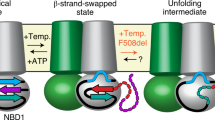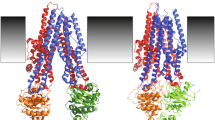Abstract
Nucleotide binding domains (NBD1 and NBD2) of the cystic fibrosis transmembrane conductance regulator (CFTR), the defective protein in cystic fibrosis, are responsible for controlling the gating of the chloride channel and are the putative binding sites for several candidate drugs in the disease treatment. We studied the effects of the application of 2-pyrimidin-7,8-benzoflavone (PBF), a strong potentiator of the CFTR, on the properties of recombinant and equimolar NBD1/NBD2 mixture in solution. The results indicate that the potentiator induces significant conformational changes of the NBD1/NBD2 dimer in solution. The potentiator does not modify the ATP binding constant, but reduces the ATP hydrolysis activity of the NBD1/NBD2 mixture. The intrinsic fluorescence and the guanidinium denaturation measurements indicate that the potentiator induces different conformational changes on the NBD1/NBD2 mixture in the presence and absence of ATP. It was confirmed from small-angle X-ray scattering experiments that, in absence of ATP, the NBD1/NBD2 dimer was disrupted by the potentiator, but in the presence of 2 mM ATP, the two NBDs kept dimerised, and a major change in the size and the shape of the structure was observed. We propose that these conformational changes could modify the NBDs–intracellular loop interaction in a way that would facilitate the open state of the channel.







Similar content being viewed by others
References
Welsh MJ, Smith AE (1993) Molecular mechanisms of CFTR chloride channel dysfunction in cystic fibrosis. Cell 73:1251–1254
Amaral MD, Kunzelmann K (2007) Molecular targeting of CFTR as a therapeutic approach to cystic fibrosis. Trends Pharmacol Sci 28:334–341
Verkman AS, Galietta LJV (2009) Chloride channels as drug targets. Nat Rev Drug Discov 8:153–171
Balch WE, Morimoto RI, Dillin A, Kelly JW (2008) Adapting proteostasis for disease intervention. Science 319:916–919
Becq F, Mettey Y, Gray M, Galietta L, Dormer R, Merten M, Metaye T, Chappe V, Marvingt-Mounir C, Zegarra-Moran O, Tarran R, Bulteau L, Derand R, Pereira M, McPherson M, Rogier C, Joffre M, Argent B, Sarrouilhe D, Kammouni W, Figarella C, Verrier B, Gola M, Vierfond J (1999) Development of substituted Benzo[c]quinolizinium compounds as novel activators of the cystic fibrosis chloride channel. J Biol Chem 274:27415–27425
Dormer RL, Derand R, McNeilly CM, Mettey Y, Bulteau-Pignoux L, Metaye T, Vierfond JM, Gray MA, Galietta LJ, Morris MR, Pereira MM, Doull IJ, Becq F, McPherson MA (2001) Correction of delF508-CFTR activity with benzo(c)quinolizinium compounds through facilitation of its processing in cystic fibrosis airway cells. J Cell Sci 114:4073–4081
Yu W, Chiaw PK, Bear CE (2011) Probing conformational rescue induced by a chemical corrector of F508del-cystic fibrosis transmembrane conductance regulator (CFTR) mutant. J Biol Chem 286:24714–24725
Chiaw PK, Eckford PDW, Bear CE (2011) Insights into the mechanisms underlying CFTR channel activity, the molecular basis for cystic fibrosis and strategies for therapy. Essays Biochem 50:233–248
Mornon J, Lehn P, Callebaut I (2009) Molecular models of the open and closed states of the whole human CFTR protein. Cell Mol Life Sci 66:3469–3486
Serohijos AW, Hegedus T, Aleksandrov AA, He L, Cui L, Dokholyan NV, Riordan JR (2008) Phenylalanine-508 mediates a cytoplasmic-membrane domain contact in the CFTR 3D structure crucial to assembly and channel function. Proc Natl Acad Sci USA 105:3256–3261
Mendoza JL, Schmidt A, Li Q, Nuvaga E, Barrett T, Bridges RJ, Feranchak AP, Brautigam CA, Thomas PJ (2012) Requirements for efficient correction of ΔF508 CFTR revealed by analyses of evolved sequences. Cell 148:164–174
Rabeh WM, Bossard F, Xu H, Okiyoneda T, Bagdany M, Mulvihill CM, Du K, di Bernardo S, Liu Y, Konermann L, Roldan A, Lukacs GL (2012) Correction of both NBD1 energetics and domain interface is required to restore ΔF508 CFTR folding and function. Cell 148:150–163
Pedemonte N, Lukacs GL, Du K, Caci E, Zegarra-Moran O, Galietta LJ, Verkman AS (2005) Small-molecule correctors of defective DeltaF508-CFTR cellular processing identified by high-throughput screening. J Clin Invest 115:2564–2571
Pedemonte N, Sonawane ND, Taddei A, Hu J, Zegarra-Moran O, Suen YF, Robins LI, Dicus CW, Willenbring D, Nantz MH, Kurth MJ, Galietta LJ, Verkman AS (2005) Phenylglycine and sulfonamide correctors of defective delta F508 and G551D cystic fibrosis transmembrane conductance regulator chloride-channel gating. Mol Pharmacol 67:1797–1807
Van Goor F, Straley KS, Cao D, González J, Hadida S, Hazlewood A, Joubran J, Knapp T, Makings LR, Miller M, Neuberger T, Olson E, Panchenko V, Rader J, Singh A, Stack JH, Tung R, Grootenhuis PDJ, Negulescu P (2006) Rescue of DeltaF508-CFTR trafficking and gating in human cystic fibrosis airway primary cultures by small molecules. Am J Physiol Lung Cell Mol Physiol 290:L1117–L1130
Yang H, Shelat AA, Guy RK, Gopinath VS, Ma T, Du K, Lukacs GL, Taddei A, Folli C, Pedemonte N, Galietta LJ, Verkman AS (2003) Nanomolar affinity small molecule correctors of defective Delta F508-CFTR chloride channel gating. J Biol Chem 278:35079–35085
Galietta LJ, Springsteel MF, Eda M, Niedzinski EJ, By K, Haddadin MJ, Kurth MJ, Nantz MH, Verkman AS (2001) Novel CFTR chloride channel activators identified by screening of combinatorial libraries based on flavone and benzoquinolizinium lead compounds. J Biol Chem 276:19723–19728
Marivingt-Mounir C, Norez C, Derand R, Bulteau-Pignoux L, Nguyen-Huy D, Viossat B, Morgant G, Becq F, Vierfond J, Mettey Y (2004) Synthesis, SAR, crystal structure, and biological evaluation of benzoquinoliziniums as activators of wild-type and mutant cystic fibrosis transmembrane conductance regulator channels. J Med Chem 47:962–972
Cai Z, Sheppard DN (2002) Phloxine B interacts with the cystic fibrosis transmembrane conductance regulator at multiple sites to modulate channel activity. J Biol Chem 277:19546–19553
Al-Nakkash L, Hu S, Li M, Hwang TC (2001) A common mechanism for cystic fibrosis transmembrane conductance regulator protein activation by genistein and benzimidazolone analogs. J Pharmacol Exp Ther 296:464–472
Caci E, Folli C, Zegarra-Moran O, Ma T, Springsteel MF, Sammelson RE, Nantz MH, Kurth MJ, Verkman AS, Galietta LJ (2003) CFTR activation in human bronchial epithelial cells by novel benzoflavone and benzimidazolone compounds. Am J Physiol Lung Cell Mol Physiol 285:L180–L188
Ai T, Bompadre SG, Wang X, Hu S, Li M, Hwang T (2004) Capsaicin potentiates wild-type and mutant cystic fibrosis transmembrane conductance regulator chloride-channel currents. Mol Pharmacol 65:1415–1426
Zegarra-Moran O, Romio L, Folli C, Caci E, Becq F, Vierfond J, Mettey Y, Cabrini G, Fanen P, Galietta LJV (2002) Correction of G551D-CFTR transport defect in epithelial monolayers by genistein but not by CPX or MPB-07. Br J Pharmacol 137:504–512
Dérand R, Bulteau L, Mettey Y, Zegarra-Moran O, Howell D, Randak C, Galietta L, Cohn J, Norez C, Romio L, Vierfond J, Joffre M, Becq F (2001) Activation of G551D-CFTR channel with the benzo[c]quinolizinium compound MPB-91: regulation by ATPase activity and phosphorylation. Am J Physiol 281:C1657–C1666
Moran O, Galietta LJV, Zegarra-Moran O (2005) Binding site of activators of the cystic fibrosis transmembrane conductance regulator in the nucleotide binding domains. Cell Mol Life Sci 62:446–460
Zegarra-Moran O, Monteverde M, Galietta LJV, Moran O (2007) Functional analysis of mutations in the putative binding site for cystic fibrosis transmembrane conductance regulator potentiators. Interaction between activation and inhibition. J Biol Chem 282:9098–9104
Melani R, Tomatis V, Galietta LJV, Zegarra-Moran O (2010) Modulation of cystic fibrosis transmembrane conductance regulator (CFTR) activity and genistein binding by cytosolic pH. J Biol Chem 285:41591–41596
Ferrera L, Pincin C, Moran O (2007) Characterization of a 7,8-benzoflavone double effect on CFTR Cl(-) channel activity. J Membr Biol 220:1–9
Galeno L, Galfrè E, Moran O (2011) Small-angle X-ray scattering study of the ATP modulation of the structural features of the nucleotide binding domains of the CFTR in solution. Eur Biophys J 40:811–824
Qu BH, Strickland E, Thomas PJ (1997) Cystic fibrosis: a disease of altered protein folding. J Bioenerg Biomembr 29:483–490
Zoghbi ME, Fuson KL, Sutton RB, Altenberg GA (2012) Kinetics of the association/dissociation cycle of an ATP-binding cassette nucleotide-binding domain. J Biol Chem 287:4157–4164
Ko Y, Pedersen P (1995) The first nucleotide binding fold of the cystic fibrosis transmembrane conductance regulator can function as an active ATPase. J Biol Chem 270:22093–22096
Pace CN, Shaw KL (2000) Linear extrapolation method of analyzing solvent denaturation curves. Proteins 4:1–7
Svergun DI (1992) Determination of the regularization parameter in indirect-transform methods using perceptual criteria. J Appl Cryst 25:495–503
Mylonas E, Svergun DI (2007) Accuracy of molecular mass determination of proteins in solution by small-angle X-ray scattering. J Appl Cryst 40:s245–s249
Konarev P, Volkov VV, Sokolova AV, Koch MHJ, Svergun DI (2003) PRIMUS: aWindows PC-based system for small-angle scattering data analysis. J Appl Cryst 36:1277–1282
Kozielski F, Svergun D, Zaccai G, Wade RH, Koch MH (2001) The overall conformation of conventional kinesins studied by small angle X-ray and neutron scattering. J Biol Chem 276:1267–1275
Franke D, Svergun DI (2009) DAMMIF, a program for rapid ab initio shape determination in small-angle scattering. J Appl Cryst 42:342–346
Volkov V, Svergun D (2003) Uniqueness of ab initio shape determination in small-angle scattering. J Appl Cryst 36:860–864
Wriggers W (2010) Using Situs for the integration of multi-resolution structures. Biophys Rev 2:21–27
Kidd JF, Ramjeesingh M, Stratford F, Huan LJ, Bear CE (2004) A heteromeric complex of the two nucleotide binding domains of cystic fibrosis transmembrane conductance regulator (CFTR) mediates ATPase activity. J Biol Chem 279:41664–41669
Van Goor F, Hadida S, Grootenhuis PDJ, Burton B, Cao D, Neuberger T, Turnbull A, Singh A, Joubran J, Hazlewood A, Zhou J, McCartney J, Arumugam V, Decker C, Yang J, Young C, Olson ER, Wine JJ, Frizzell RA, Ashlock M, Negulescu P (2009) Rescue of CF airway epithelial cell function in vitro by a CFTR potentiator, VX-770. Proc Natl Acad Sci USA 106:18825–18830
Accurso FJ, Rowe SM, Clancy JP, Boyle MP, Dunitz JM, Durie PR, Sagel SD, Hornick DB, Konstan MW, Donaldson SH, Moss RB, Pilewski JM, Rubenstein RC, Uluer AZ, Aitken ML, Freedman SD, Rose LM, Mayer-Hamblett N, Dong Q, Zha J, Stone AJ, Olson ER, Ordoñez CL, Campbell PW, Ashlock MA, Ramsey BW (2010) Effect of VX-770 in persons with cystic fibrosis and the G551D-CFTR mutation. N Engl J Med 363:1991–2003
Ramsey BW, Davies J, McElvaney NG, Tullis E, Bell SC, Dřevínek P, Griese M, McKone EF, Wainwright CE, Konstan MW, Moss R, Ratjen F, Sermet-Gaudelus I, Rowe SM, Dong Q, Rodriguez S, Yen K, Ordoñez C, Elborn JS (2011) A CFTR potentiator in patients with cystic fibrosis and the G551D mutation. N Engl J Med 365:1663–1672
Sanders DB, Farrell PM (2012) Transformative mutation specific pharmacotherapy for cystic fibrosis. BMJ 344:e79
Kaiser J (2012) Personalized medicine. New cystic fibrosis drug offers hope, at a price. Science 335:645
Allen J (2008) Biophysical chemistry. Wiley, Oxford
Zeltwanger S, Wang F, Wang GT, Gillis KD, Hwang TC (1999) Gating of cystic fibrosis transmembrane conductance regulator chloride channels by adenosine triphosphate hydrolysis. Quantitative analysis of a cyclic gating scheme. J Gen Physiol 113:541–554
Vergani P, Lockless SW, Nairn AC, Gadsby DC (2005) CFTR channel opening by ATP-driven tight dimerization of its nucleotide-binding domains. Nature 433:876–880
Wellhauser L, Chiaw PK, Pasyk S, Li C, Ramjeesingh M, Bear CE (2009) A small-molecule modulator interacts directly with deltaPhe508-CFTR to modify its ATPase activity and conformational stability. Mol Pharmacol 75:1430–1438
Wrabl J, Shortle D (1999) A model of the changes in denatured state structure underlying m value effects in staphylococcal nuclease. Nat Struct Biol 6:876–883
Acknowledgments
We thank Francesca Spanò and Olga Zegarra-Moran for their comments. This work was supported by the Italian Cystic Fibrosis Research Foundation Grant #7/2010, with the collaboration of Delegazione FFC di Cosenza 2, Work in Progress Communication “Sapore di Sale 2010”, Gruppo di Sostegno di Monterotondo (RM), Delegazione FFC di Genova, Delegazione FFC “Il Sorriso di Jenny”, LIFC Comitato provinciale di Livorno. We thank the ESRF for provision of synchrotron radiation facilities, and we would like to thank Petra Pernod for assistance in using beamline ID14-EH3.
Author information
Authors and Affiliations
Corresponding author
Rights and permissions
About this article
Cite this article
Galfrè, E., Galeno, L. & Moran, O. A potentiator induces conformational changes on the recombinant CFTR nucleotide binding domains in solution. Cell. Mol. Life Sci. 69, 3701–3713 (2012). https://doi.org/10.1007/s00018-012-1049-7
Received:
Revised:
Accepted:
Published:
Issue Date:
DOI: https://doi.org/10.1007/s00018-012-1049-7




